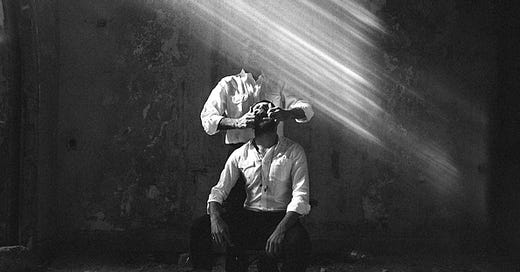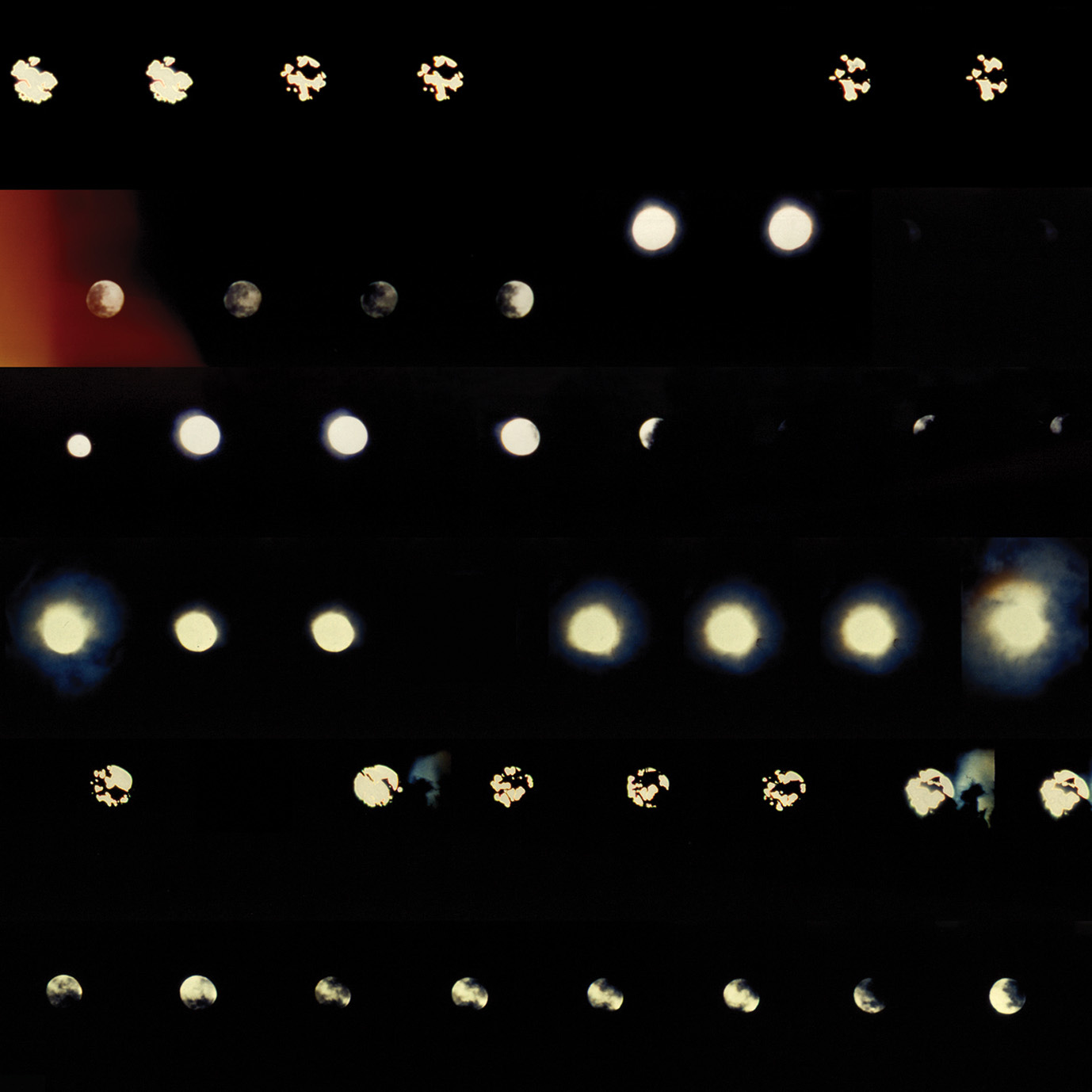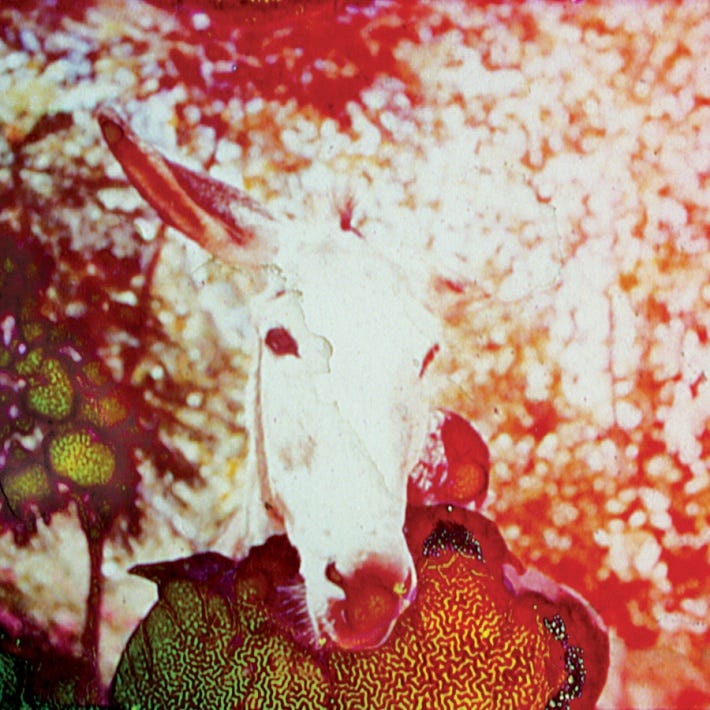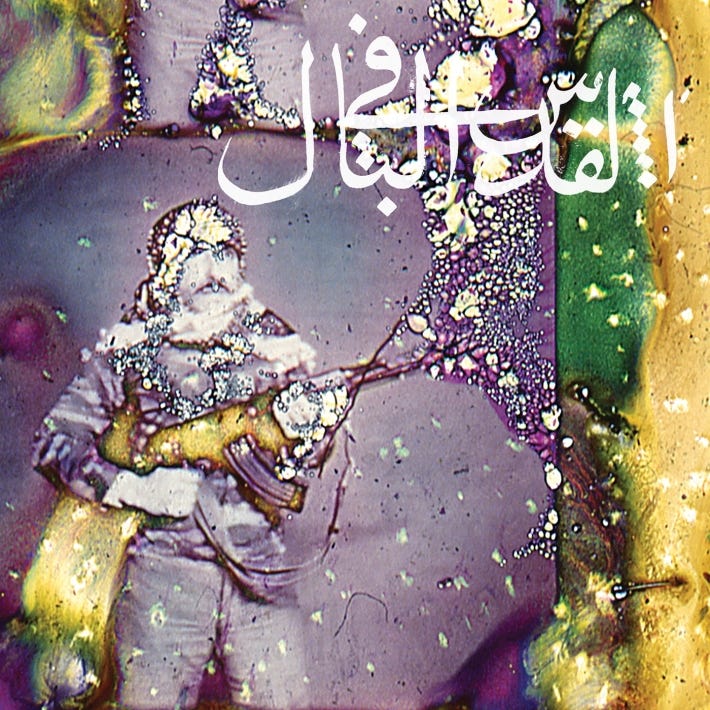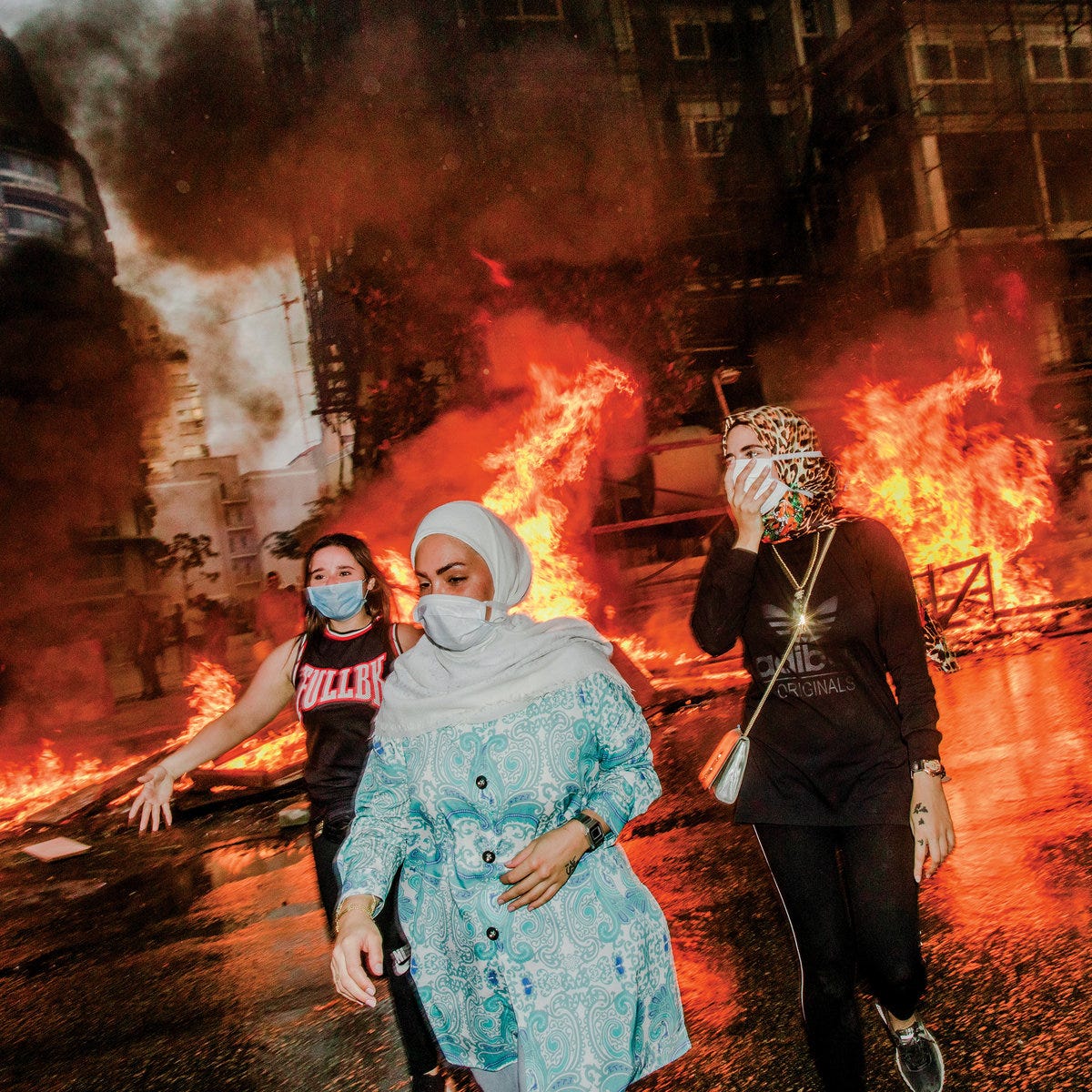Lebanon has been on my mind, for obvious reasons. I recently wrote about Yara Asmar’s Stuttering Music, the release of which has sadly coincided with this latest resurgence of conflict. So I thought for I’d put together a compilation of our writing on Radwan Ghazi Moumneh’s long running audio-visual project, Jerusalem in My Heart. I first saw Jerusalem in My Heart in 2005, opening for A Silver Mt. Zion’s US debut at Southpaw in Brooklyn. It was a solo project at that point, but the truth is I’d forgotten all about this until I found the ticket stub many years later. (As an archivist, historian, and all around lover of ephemera—or a hoarder if you want to be a jerk about it—it strikes me that this foregrounds a sad consequence of the move away from physical tickets. But I digress.) By the time I’d moved to Montreal in 2009, I had more frequent opportunities to witness the project’s evolution, including the release of their debut, Mo7it Al-Mo7it. In 2014, in advance of their performance at the great festival in Victoriaville, Quebec, I interviewed Radwan about the project. Below, you’ll find that interview/article, as well as reviews for each of the full-length JiMH records.
Jerusalem in My Heart hits the road (2014)
Article originally published May 15, 2014 at Cult MTL
For their 30th edition, the organizers of the FIMAV festival in Victoriaville reached back throughout their archives to assemble an all-star program, but rather than just bring in big name performers who have been on the world stage since the ’60s, they made sure to balance the schedule with plenty of young artists from Quebec, including Montreal’s Jerusalem in My Heart.
Jerusalem in My Heart is a unique multi-media performance project led by Radwan Ghazi Moumneh, a convergence of contemporary Arabic and electronic musics accompanied by “light-based (de)constructions of space.” JIMH sets out to mine the relationship between music, visuals, projections and their audience, with no two performances being alike. Launched in 2005, it wasn’t until last year’s Mo7it Al- Mo7it on Constellation Records that JIMH appeared in recorded form. Though always led by Moumneh, the line-up has varied from solo performances to up to 35 additional musicians. Subsequent touring of Europe following the record revolved around the trio of Moumneh, Jeremie Regnier and visual artist Malena Szlam Salazar.
Jerusalem in My Heart recently began a short Canadian tour which will end with a performance at Montreal’s Suoni per il Popolo festival in June, including a special performance at Victo this Friday. This tour marks the inauguration of a new creative phase for the project: Moumneh will perform alone, accompanied by visual projectionist Charles-André Coderre (though you can expect a few guest performers at the Montreal show). The duo will manipulate 16mm and 35mm projections to keep the space in constant flux, accompanying Moumneh’s reverb-drenched vocals and various traditional and electronic instruments. Regardless of the size of the band or the space they’re playing, JIMH sets out to “occupy a space in the best way we can, in setting up our visual component to create a mesmeric ambiance that can hopefully connect with an audience.”
Moumneh is deeply enmeshed in Montreal’s music scene, as co-owner of the Hotel2Tango analogue recording studio in addition to serving time in other bands including Pas Chic Chic and Sam Shalabi’s Land of Kush. After eight years of JIMH performing once or twice per year, the time finally came for Moumneh to challenge himself with new audiences. He feels that “to a certain degree, I wasn’t presenting work to a Montreal audience that was a challenge, be it culturally or politically. The standard was set for what I did and I felt like I was often meeting people’s expectations and whatnot, which didn’t sit right with me. The idea of bringing this performance to an audience that has no ‘history’ with me simultaneously scared and excited me.”
As a Lebanese national who grew up in Oman and has lived in Canada for over 20 years, questions of Arab identity are at the heart of Moumneh’s work. “I’m mostly in the circle of experimental, post-rock, indie-whatever tour scenes, and these are not the circles where an Arab has a voice.”
Moumneh’s interest in the cassette culture of Syria is well documented, and the particular aesthetic of these tapes, a “blown out” sound of overloaded recordings and excessive echo effects, influenced the sound of Mo7it Al-Mo7it. There’s been quite a bit of discussion about this sort of music since Syrian wedding singer Omar Souleyman was marketed to Western audiences and championed by pop stars like Björk.
“The music had to become ‘cool’ in the West in order for it to become cool in the Middle East,” which raises complex questions about how music in commodity form travels across cultures. We may trust the good intentions of Alan Bishop and his Sublime Frequencies label, but there is a valid critique in the way promoters and the media have marketed Souleyman’s records.
Souleyman will also be performing at the Suoni festival next month, and so I asked Moumneh his opinion on this recent hipster fascination with this music. “It is a delicate subject, as for the most part, people in the West issuing these records are doing it out of a genuine love for the music. Yes? Problem is, how is this then marketed on one level, and on another, how is it disseminated, and turned into an exotic flavour of the moment via various online musical outlets with such amateur writing and gross politics, and not taking any journalistic responsibility in truly understanding what it is they’re writing about. It’s not the Bishops of this world who are pulling these strings, and neither is it the Souleymans. They are just artists trying to make a living in doing what they know how to do.”
Around the time that Souleyman was finding an audience in the West, Mark Gergis also compiled a compilation of Syrian Dabke music which places the genre in its broader context, music that is mostly looked down upon in the Middle East.
“This is just but one of many layers of classist and racist mindsets in any post-colonial culture. It’s seen as music that is made by the lower class, by Kurds, by Turkmanis, by Shia, by Bedouin, etc. It’s never what you’ll hear in downtown Beirut. Never. Except… that you WILL hear Mark’s record, because Mark put it out! Not because it’s good — it of course is! An actual tape of the same music that was made on a dubbed tape or a vcd, will never be played, as the context of it is such that it is frowned upon. It’s like an expensive wine served in a dep wine bottle that can’t be appreciated because of context.” ■ (Joseph Sannicandro)
Jerusalem in my Heart ~ Mo7it Al-Mo7it (2013)
For the last eight years Jerusalem In My Heart has been blending electronic music, contemporary Arab music and immersive film projections, but this is the first album they have ever recorded. In the past, group founder Radwan Ghazi Moumneh was not interested in a definitive recording; JIMH is meant to be a live experience. The film projection aspect is more than just video, as film artist Malena Szlam Salazar uses up to six 16 mm film projectors to play with space and light wherever a performance takes place. And while concerts may involve just the three core members, the group has a lot of friends in Montreal so it wouldn’t be unusual to have thirty or more people on stage. No two performances are alike.
How does an artistic project that is so shape-shifting translate to an album? The opening snap of vocals on Mo7it Al-Mo7it sound less like a prayer, and more a warning. My Arabic is pretty clumsy, and I don’t know what Moumneh is singing about, but the high amount of reverb recognizes an immediate relationship between Western and Eastern audio climates. The simmering drones and synths that soon accompany the multiplying vocals reveal a psychedelic bent, one that refuses to be put in a box as each song further unfolds. Moumneh spends three months of the year in Lebanon, working in the local experimental music scene, and while I’ve heard musicians of Lebanese descent mixing instruments and styles before (Claude Chalhoub is nice, albeit a quite new agey), this album is the first that is purely transformative to my ears, and absolutely unique.
It’s a true delight to come across an album whose disparate cultural starting points are written on the wall but sound completely natural together. Second track “3andalib Al-Furat” is a peaceful drift down a river. Many birds join in while Moumneh dreamily plays acoustic buzuk, zurna and piano. These gentle ten minutes assuage the echoing conjunction of sounds on the first track, as if we have escaped massive civilization, revealing the smells and sounds from a smaller, cobblestoned Lebanese village. Then the third movement enters in “Yudaghdegh El-ra3ey Walal-Ghanam” (or “He titillates the shepherd but not the sheep”), a cascade of bioluminescent synth staircases and gentle but urgent vocals. And oh, those harmonies! They are divine, sounding a lot like those that Maynard Keenan uses quite a lot in Tool’s holier moments. They behave like candlelight on a night with no moon. This is one of those pieces of music that is surprisingly short considering how time-expanding it feels.
Each track is a portal into the next, and a balance between the blown-out electronic sounds and the more holistic instruments is truly achieved. The peace of the songbirds and river appears once more before the mesmerizing “Ko7l El-3ein, 3emian El-3ein” takes us to the pinnacle of the story, with an electric guitar played in a scale fitting of a cross-desert voyage. Here the guitar is like the hero’s stallion as Moumneh rides it through the final two tracks, the latter of which is a compelling conversation between horse and rider whose ending is haunting and powerful.
Inspired by the book Al-Muhit al Muhit (“The Ocean of Oceans”) by the innovative Lebanese renaissance educator Butrus al-Boustani, Mo7it Al-Mo7it and all its song titles are written as if you were typing in Arabic on your mobile phone. Embracing a culturally unifying text and texting from one side of the world to the other is a bizarre pairing that is now part of our reality. No doubt the difference in patience and care required for these two things is about as vast as the ocean, and Jerusalem In My Heart’s debut record is a reflection of much care and patience in the face of this fretful age of the cheap and easy. It is a rock and roll gem among the pallid detritus known as “world fusion music.” This album has a mature and unbridled energy that defies classification, and I cannot recommend it enough. (Nayt Keane)
Jerusalem in My Heart ~ Mo7it Al-Mo7it (Constellation)
The long jams and experimentalism of psychedelic music have always carried an air of adopted mysticism and prayer, which is why the journeyed fusion of Arabic traditions and Western electronic compositions feels so natural on Jerusalem In My Heart’s debut. A near decade of production experience puts this record in the “timeless” realm. It sounds like nothing you’ve really heard before, and yet it could be mistaken for something lost from the 1970’s. Radwan Ghazi Moumneh’s emotive vocals are rock and roll prayers shot through tape echoes and subtle distortions. The music acts like a gentle desert breeze or a white hot crown chakra of self awareness. The band’s performances use music and film projectors to create a uniquely visceral experience. (Nayt Keane)
Jerusalem In My Heart ~ If He Dies, If If If If If If (2015)
Constellation is having another banner year, with first-half albums by Matana Roberts, Godspeed You! Black Emperor and Colin Stetson and Sarah Neufeld already making an impact. Their next hit comes from the fiery international duo Jerusalem In My Heart. Even more remarkable than the fact that they don’t sound like a duo is that the music is made by only one (Radwan Ghazi Moumneh), while his partner Charles-Andre Coderre contributes the visuals that form an integral part of the live set. Guest stars do appear, but never more than two at a time.
The music is in turns pensive, angry and frenzied. While the lyrics are in Arabic, translations are available, referencing hope, betrayal and accusation, culminating in the timely question, “Oh, what’s the matter with you, Syria?” Such politics are hidden to the common Western listener, but expose veins of conflict in the Arab mindset. Not everyone is dangerous, but neither is everyone benign.
Perhaps the best facet of the album is its continued movement away from the Buddha Bar sound that marred so many interpretations of Arabic music. The common assumption was that it was played only in temples, for meditation or for holy dancing. Confronting such stereotypes with heartfelt playing, Moumneh offers an alternative take on world music: not the blandness of new age, but the sharp edges of cultural difference. Sure, there’s dance music here (“Lau Ridyou Bil Hijaz”), but of a much more authentic nature than Westerners are accustomed to hearing. No, we are not all the same.
The buzuk (long-necked lute) features strongly, demonstrating the expansion of timbre that can occur when even one underused instrument is integrated into a modern rock structure. Bansuri flute makes an appearance as well. Ironically, the biggest impact is felt on album highlight “Qala Li Kafa Kafa Kafa Kafa Kafa Kafa (To Me He Said Enough Enough Enough Enough Enough Enough)”, as a contact mike in Moumneh’s mouth produces a loud, dark drone. What seems initially like a risk turns out to pay huge dividends, as the piece grows devastating in scope. It’s the greatest example of the duo’s desire to put everything on the table: Arabic history, sociological disgust, ancient instruments and electronics. Blasts of white noise nearly drown everything in their wake, yet the buzuk survives the onslaught. It’s as if to say that cultures can indeed survive modernity, and valuable messages can be heard above the din. Beauty lies in the heart of noise, if only we have the ears to discern it. (Richard Allen)
Jerusalem in My Heart ~ If He Dies, If If If If If (Constellation)
The third Constellation album of this Top Ten boasts one of the year’s best titles to boot. It’s all the work of one very hard-working man, with a few friends rounding it out. Even without the intended visuals, the music retains its power. If this isn’t quite the year of the buzuk, it’s the still a year in which Arabic music became even more essential. The world may be in turmoil, but the sides are not as clear as politicians would have us believe. (Richard Allen)
Jerusalem In My Heart ~ Daqa’iq Tudiaq (2018)
There’s a lot to unpack with this record, but the easiest entry point is just to listen. What do you hear? What do you associate with what you hear? How does the music make you feel?
Arabic music sounds different to Western ears. We’re not accustomed to hearing the buzuk, riq, oud, qanun, and santer. To demonstrate the unfamiliarity of these names, autocorrect has changed my words to buzz, Rio, our, quaalude, and saunter, leaving only the derbakeh alone while underlining it in red. Even our Western computers are dismissing the “foreign” culture, not allowing their words to be written. The grammatical program insists that it is right: smarter, superior. A digital border appears before the music even plays.
When it does, it’s beautiful, beguiling, astonishing. Jerusalem In My Heart is a blend of West and East, Montreal and Beirut, that merges facets of each world. The wonderful first side, “Wa Ta’atalat Loughat Al Kalam,” is a transcendent entry point into a world of shared culture, one without borders in which ideas are freely exchanged. The music flows like a worship service, eventually eradicating all concept of time. Radwan Ghazi Moumneh’s voice hangs over it all, although we don’t yet understand what he’s saying; the voice comes across as another instrument, the original instrument. Some still hear threat in the Arabic voice; others hear beauty. The same is true on the other side of the cultural divide. We have to listen to understand.
So let’s take another angle: what does Google say? Google translate, known for its mangling properties, translates the title as “And the languages of the mother went down,” which seems poetic and perhaps even accurate based on the current topic. The track itself is based on another work, which Google calls “O Valley of the Valley.” But Constellation translates the titles as “The Language of Speech Has Broke Down,” a sentence whose grammatical error may be extremely clever (“Watch out for strange verbs which has crope into our language”) or an extension of the problem; and “Oh Neighbor of the Valley,” which makes more sense. Thankfully, music has its own unifying language.
As the vocals recede and club beats emerge, we intuit this language: the language of dance. One need not be Western or Eastern, religious or atheist, to surrender to the beat. “Bein Ithnein” (“Between Two”) is a marvelous transition point. The combination of chant and electronic stutter in the subsequent piece represents the best of two worlds. The style changes from flowing to halting as the music falls into silence again and again, implying the silence of active listening. Truth lies in the pauses.
We’re still missing something ~ the 16mm work of Charles-André Coderre. Jerusalem In My Heart is a duo, although half is heard and half is seen. Together, they complement each other’s artistry, lending new tones to already-bursting palettes. If Daqa’iq Tudaiq is any indication, such an experience may offer the fulfillment of their dream: that multiple cultures might mingle in a shared space, speak with each other in the silent spaces and dance together as the music reminds them of their commonality. (Richard Allen)
Jerusalem in My Heart ~ Dada’iq Tudiaq (Constellation)
Radwan Ghazi Moumneh’s third album of his constantly evolving JIMH is that project at its most refined, and perhaps also most polarized. The A-side long modern orchestration of a nearly century old Egyptian pop classic is played almost straight, with subtle electronics, noise, and distortion creeping into to the otherwise fairly conservative arrangement, directed by Montreal/Cairo-based Sam Shalabi. The song was written by the famous singer and composer Mohammad Abdel Wahab, known for his patriotic anthems yet often criticized for excessive engagement with Western music. Perhaps this disregard paid to imposed restrictions appealed for Moumneh. The four songs on the B-side are mainly solo affairs, occasionally harsh deconstructions of voice and instrument. As always, JimH is an audio-visual project, and Charles-André Coderre album art and videos, drawn from experimental treatments of archival photographs, furthers the conceptual intervention at the heart of Daqa’iq Tudiaq. (Joseph Sannicandro)
Jerusalem in My Heart ~ Dada’iq Tudiaq (Constellation)
Simultaneously mournful and sentimental, the first half of Daqa’iq Tudiaq is a poetic entry into the sublime sound-world of JIMH, characterized by an experimental approach that lays bare the intensity of Arabic melodies and their labyrinthine flows. They grow and slide into subtle distortions, the traditional instrumentation lending an air of both nostalgia and a sense of being temporally displaced, songs of love lost somewhere, sometime beneath the cracks of a war-torn wall. The second half of the album wonderfully potentializes the heartbreak of the first, both in the complexity of the instrumental sections and the genuine tone of sadness of its vocals, subjected to monstrous echoing by means of electronic processes; tradition shines a light, but it is not enough to clear the skies from the smoke of missiles. Such is the promise of new music: a brilliant something beating at the heart of novelty, an aesthetic path to freedom that does not entirely reject the old but builds upon it. (David Murrieta Flores)
Jerusalem in My Heart ~ Qalaq (2021)
As global turmoil continues to rise, Jerusalem In My Heart‘s music grows even more relevant. Qalaq decries the situation in the Middle East, and incorporate different collaborators on almost every track. Lucretia Dalt, Oiseau-Tempête, Tim Hecker and many more join an already dynamic collective, which now includes a visual angle as well. A limited number of box sets are available, which include film reels and a hand-stitched book

